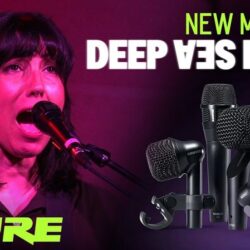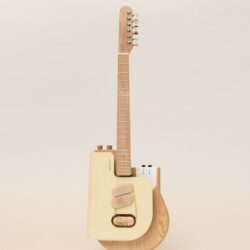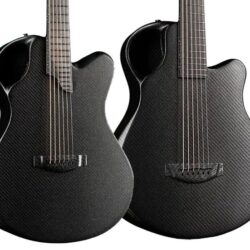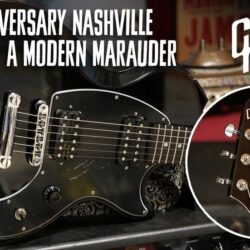
PRS Guitars Releases New Rules of Tone Video Series
PRS Guitars today released the first episode of a new video series on the PRS “Rules of Tone.” The Rules of Tone is a document written by Paul Reed Smith back in 2006, in which he documented 21 “rules” that he and the guitar makers at PRS follow in order to ensure instruments of the highest quality. “It was meant to be a guide so that I/we always build the best instruments we can possibly make. There are 21 rules – each one the culmination of decades of experience in guitar-making, design, and repair work. While no set of rules can guarantee a perfect instrument, a guitar should improve with each instance of a rule followed – in the end becoming greater than the sum of its parts,” said Paul Reed Smith.The video series will be published as six episodes in total. Episode 1 focuses on woods and is available now at this link. Remaining topics include: necks, pickups, finish, hardware, and setup. In each video, Paul Reed Smith is joined by a member of the PRS Guitars manufacturing team to talk about how the guitar-making philosophies are applied in practice on the manufacturing floor. To see each episode as soon as it is released, subscribe to the PRS Guitars YouTube channel and click the bell for notifications. “Since 2006, I have spent a lot of time teaching these guitar-making principles to the teams here. The teams have, in turn, become stewards of the rules to every person who makes guitars for PRS. Please enjoy these videos. It is my hope that they give you an idea of the amount of care and constant improvement we dedicate ourselves to, so that you receive our best,” said Paul Reed Smith.PRS Guitars continues its schedule of launching new products each month in 2025. Stay tuned to see new gear and 40th Anniversary limited-edition guitars throughout the year. For all of the latest news, click www.prsguitars.com/40 and follow @prsguitars on Instagram, Tik Tok, Facebook, X, and YouTube.
Read more »
The Glen Campbell Effect
Glen Campbell’s sound is inspiring on many levels—in addition to his distinctive voice, his nuanced and virtuosic guitar playing allowed him to interpret some of the most iconic songs of his era. Among them, the songs of Jimmy Webb stand out immediately. Classic pieces such as “By the Time I Get to Phoenix” and “Wichita Lineman” are instantly recognizable for their vivid storytelling and unforgettable melodies. It’s interesting to note that Webb composed on piano, utilizing the instrument’s vast harmonic capabilities to craft structures less conventional than the typical radio single. In the hands of Campbell, his guitar playing truly shines as much in his comping as in his famous soloing during live performances. I composed my piece, “Jed’s Theme,” based on a character in a novel written by my sister, Christina Rauh Fishburne, with Webb and Campbell’s influence very much at the center. It can be heard on my album with Cameron Mizell, Local Folklore (Destiny Records).Note: I play this piece with hybrid picking (pick/middle/ring), but it can also be played fingerstyle if that’s more comfortable.Ex. 1 (Measures 1–8)The beginning of the tune establishes a simple melody line over a harmonic bed that utilizes inversions and substitutions for color. An element of Campbell’s accompaniment style that I love is his ability to sculpt emotion to support the melody. In an instrumental context like this, using a Gm as a passing thought in measure 2 is a way to emote harmonically while only briefly straying from the key of D major. The decision to use F# in the bass of the tonic D chord also provides a chromatic line as we move through D/F#, Gsus4, Gm, D/F#, and G6. These nuanced voicing movements help to create an atmosphere for the melody beyond the typical options. The rocking back and forth of the bass notes also provides a momentum to move up to the V–IIIm–IV cadence that ends with a first position line over Gmaj. Adding such lines in an instrumental tune can be a fun way to insert “guitar” back into the melody. By this I mean that until then, think of the melody as a voice. The melody sings its entrance and comes to a pause, leaving space for the guitar to respond before moving on.Ex. 2 (Measures 9–16)Here, we find ourselves back in the “voice” melody but now E/G# is introduced as a harmonic shift to bring light into the melodic narrative before closing out the phrase by resolving to a Dmaj walk up. At the start of the song, the melody hangs on the G6 chord before extending tension over the V and IIIm chords and settling on the IV chord before beginning its next statement. This time, we bring the melody to a secondary dominant with the V of V (E/G#) before finally resolving to the I chord. This is a mechanism often found in the Webb/Campbell songs that allows a melody to remain consistent while simultaneously offering emotional development.Ex. 3 (Measures 17–23)We begin here with a higher melodic line voiced over the V chord before descending out of the key briefly to Fmaj7–Fmaj9–Cadd9. Following this, another “guitar” line enters to lead us back into D major by closing out the phrase on A7, further utilizing harmonic movements under the melody to introduce new emotive colors and support the melody.Ex. 4 (Measures 9–13, coda ending)To bring the song to an end, we take the D.S. al Coda and introduce a final harmonic shift with the G/Ab beginning the coda and ending on the unresolved Gm. These choices are both ways in which a song can be brought to a closing that feels open-ended, which is different than incomplete. Rooted in the key of D major, the song remains mostly grounded in the tonality with various harmonic divergences to accent the melody. By ending the song on the Gm, or the IVm, we may insinuate that a story is still being told after the song is finished. This is a mechanism often used to accentuate unresolved tension in vocalized lyrics and can have the same effect with instrumental music when thoughtfully placed.Ex. 5For Ex. 5, we’ll play the complete piece, keeping in mind that it’s important to hear the melody lyrically, and the harmony as emotional color in support of it.
Read more »
Shure Nexadyne Mics on Tour with Deep Sea Diver
PG’s Chris Kies catches up with Jessica after filming DSD’s latest Rig Rundown to get her first impressions of the Nexadyne lineup.Deep Sea Diver’s Jessica Dobson is a longtime fan of Shure mics on stage and in the studio. So, when Shure outfitted their latest tour with the new Nexadyne series mics, the band was excited to put them through their paces to see how they stack up against legends like the sm57 and sm58 for reliability and tone.Shure Nexadyne 5 Guitar Amp Microphone
Nexadyne 5 Amp Mic, BlkThe Nexadyne™ 5 Dynamic Guitar Amp Microphone is a supercardioid dynamic microphone for professional live performance, featuring patented Shure Revonic™ dual-engine transducer technology.Shure Nexadyne 8/S Dynamic Vocal Microphone
Nexadyne 8/S Supercard Vocal Mic, BlkDynamic Vocal Microphone with Cardioid Pickup Pattern, Dual-engine Design, Revonic Transducer Technology, Dent-resistant Grille, Mic Clip Stand Adapter, and Zipper CaseShure GLXD16+ Digital Wireless Guitar Pedal System
GLXD16+ Wls Gtr Pedal Sys
Read more »Five For Friday: August 15, 2025
This week’s set of new releases cuts deep with the latest from Castrator, Grand Cadaver, Unleashed and more!
The post Five For Friday: August 15, 2025 appeared first on Decibel Magazine.

Autographed BENT SEA (Featuring Members of MEGADETH/NAPALM DEATH/ABORTED) Decibel-Exclusive Vinyl! PREORDER NOW!
There are only 100 AUTOGRAPHED copies of Bent Sea’s debut LP, The Dormant Ruin, on exclusive Tidal Fire Gold vinyl. Get one EXCLUSIVELY via Decibel!
The post Autographed BENT SEA (Featuring Members of MEGADETH/NAPALM DEATH/ABORTED) Decibel-Exclusive Vinyl! PREORDER NOW! appeared first on Decibel Magazine.

Verso Sine Review
Verso demoOver the course of electric guitar history, there have been many experimental builds. Some have been successful and changed the path of guitar design, while others have come and gone, surfing the seas of change. The Verso Sine, though, lives in a third, less common category—an artistic realm populated by names like Wandre and Manzer, where visionary builders rule the roost.Since launching Verso a handful of years ago, Germany-based builder Robin Stummvoll has caught the attention of intrepid design fans with his minimal, sheet-metal-bodied Cosmo guitar, Orbit baritone, and Gravis bass. His distinctive style is based on future-leaning aesthetics that also draw on the early history of electric guitar design—specifically Rickenbacker’s sheet-metal lap steels—as well as mid-century furniture and architecture. With the Sine, Verso pushes further ahead. Aesthetically, this model would sit nicely in the design wing of a modern art museum, maybe across the hall from an Eero Saarinen exhibit. That alone is cause for excitement. But the Sine, described by Stummvoll as an “expressive guitar,” offers a playing experience unlike any other guitar I’ve laid my hands on. And that is the real experiment at the heart of this fantastic instrument. Rethinking Guitar DesignUnlike its metallic siblings, the Sine is actually made of a solid ash body with a set neck—available as ash, maple, cherry, oak, or walnut—with the option of a 16″ or compound 9 1/2″–16″ radius. The Sine Pad, a 1 mm-thick piece of bent sheet metal that’s affixed to its body, serves as the guitar’s top and home to the pickups.The Sine Pad opens up a world of possibilities that are game-changing, highly innovative, and practical. First, there’s the pickups. Since the Sine Pad is powder-coated steel, the magnetic pickups cling to the top without needing to be permanently affixed, so they can be moved in any direction. That means they can be shifted in relation to the strings to shift the tone. But thanks to stereo-output options (which are configured on the back of the guitar, where the guitar’s input jack is located, and where the pickups plug in via mini audio jacks), both of the Sine’s single-coil pickups can be moved so one pickup captures only the top strings and the other captures just the bottom. The resulting stereo imaging effects can be pretty wild. Because the Sine Pad is a floating, spring-loaded piece of sheet metal and the brass bridge is independently situated on the body, you can also create volume-swell effects by pressing on the top without changing pitch. I found that a different kind of musical intuition comes into play when working with the Sine Pad. The control it offers is more nuanced and directly tied to my picking hand technique than what I would achieve with a volume pedal or knob. It’s a great tool for quick, expressive swells. Volume isn’t the only control the Sine Pad has to offer. An onboard LEHLE EXPRESSION module is connected to the Sine Pad, with two expression outs (it’s also compatible with CV and USB MIDI) that I used to control pedals with expression options. Plugged into my Red Panda Tensor or Moog Minifooger MF Delay, I experienced a sense of effect control like never before. I tapped into delay times both subtle and extreme with the same intuitive gestures that controlled my chord and note attack. It’s something I haven’t been able to emulate without the Sine—a unique feeling almost like playing with a whammy bar for the first time. The Essential Guitar-ness of the SineThe Sine’s wild innovations wouldn’t mean much if it weren’t an excellent guitar. Sure, it looks completely unlike anything else. But holding the Sine in my lap, closing my eyes, and putting fingers to frets and strings, it’s a comfortable, playable instrument. It’s a little body-heavy, and the lack of curvature on the lap side means it can drift if you don’t sit with it centered. But those issues aside, the drawbacks are few.The fretboard feels great, and there’s plenty of access to each of the Sine’s 22 nicely rounded Jescar frets. Acoustically, it’s loud and resonant, with warm but metallic overtones similar to my Jazzmaster with an aluminum pickguard, or a fuller, bigger guitar version of my sheet-metal Rickenbacker NS lap steel. The pickups certainly play a role in balancing the metallic overtones, and their wooden housing even gives a little extra sense of warmth, at least visually. Yet as fun as it is to lean in and dose the Sine with enough effects to match its futuristic tendencies, this well-rounded sonic foundation demanded I spend just as much time using its clean tone to play complex voicings across the neck.The Verdict The Sine is essentially an experimental instrument for daring players looking for something different. It absolutely succeeds, however, not only by offering a range of expression unlike any other guitar, but by doing so in a way that is simple and practical—a combination that defined the greatest mid-century guitar-design icons. I’ll share one warning for those who experiment with this guitar, though: Since parting with the Sine, I’ve missed the sense of expression it put at my fingertips, and there’s only one way to experience that feeling again.
Read more »
What’s New: August 16, 2025
Whiskey Myers Rig Rundown with John Jeffers & Cody TateThe high-powered Southern rockers return for a full-on Rig Rundown.This “Les Paul” Isn’t What You Think…Gibson commemorates 50 years in Nashville with an unexpected, limited edition evolution of their understated Marauder.Verso Sine ReviewUnique expressive features from a futuristic instrument that still nods at electric guitar design history.Gibson Custom Creates Noel Gallagher Les Paul StandardExclusive: Full details of the black Gibson Les Paul Standard seen and heard at Oasis reunion showsPRS Guitars Releases Special Limited Edition of the CE 24PRS Guitars today announced a new limited edition: the PRS CE 24 Special. “Special” in the name refers to this guitar’s hum/single/hum pickup configuration, a first for the CE bolt-on platform. Only 1,500 of this limited-edition model will be made for 2025.Megadeth to Release Final Album in 2026Global music icon Dave Mustainereveals next album will be final studio albumof his more than four-decade career.
Read more »
Emerald Guitars Unveils Black Opus Acoustics
Emerald Guitars has introduced its most accessible range yet, the Black Opus Series of acoustics. Crafted for players who want that Emerald tone, playability, and reliability without paying for custom aesthetics or extras, the Black Opus comes in two sizes: the X7 parlor guitar and the signature dreadnought X20.Focused on sound, playability and reliability, the stripped-back Black Opus is the definitive no-frills Emerald — including a Crystal Ice satin finish and streamlined component choices. Emerald Guitars has reduced the cost without reducing quality. The Opus series come with no veneers or custom options – just the essentials. Paired with a minimalist, studio-grade preamp design, it delivers a warm, clean signal that preserves the true voice of the guitar. That sums up the Black Opus philosophy: pure tone, no excess.
Built in Donegal, Ireland to the same standards as every Emerald, the Black Opus features include:
Black carbon fiber weave with Crystal Ice satin texture finishLR Baggs Element Bronze undersaddle piezo pickupEmerald 14:1 gear ratio tunersPinless carbon bridge, full carbon fiber constructionErgonomic, comfortable designsExpert setup and PLEK serviceEmerald Gig Bag includedThe Black Opus X7 is Emerald’s compact, parlor-sized acoustic — designed for players who want full-bodied tone in a smaller, travel-friendly form. With its ergonomic carbon fiber body and 24” scale length, the X7 offers comfort and playability, whether you’re at home, on the road, or on stage. Despite its small footprint, the X7 delivers a surprisingly rich and balanced tone, for those seeking portability without compromise.The X20 Black Opus is designed for players seeking a rich, full-bodied acoustic tone with comfort and durability. Its ergonomic carbon fiber body contours naturally to the player, allowing for long sessions of effortless performance — on stage, in the studio, or on the road. Since its debut, the X20 has remained Emerald’s most popular model — a bold evolution of the traditional dreadnought. With extended neck access, a subtle rib bevel, and a contoured fretboard end, the X20 delivers advanced playability and a modern feel while staying true to its original character.The X20 Black Opus dreadnought carries a street price of $1895; the X7 Black Opus parlor model carries a street price of $1695. For more information visit emeraldguitars.com.

This “Les Paul” Isn’t What You Think…
Gibson commemorates 50 years in Nashville with an unexpected, limited edition evolution of their understated Marauder.For 50 years, Gibson has been proud to call Nashville home, shaping sound, supporting the artists who make our community special, and crafting the guitars that have defined generations of music. Now, we’re honoring that legacy with something new. Introducing the Les Paul Music City Special – 50th Anniversary, a tribute to where we’ve been and a celebration of where the music will lead next. The Music City Special – 50th Anniversary is an updated, modern twist on two historical Gibson models, taking much of its inspiration from the 70s-era Marauder, with a touch of the Music City Junior in its DNA. Over the years, the Marauder has been used by artists from Adam Jones to Paul Stanley. This unique commemorative model pays tribute to the early days of Gibson’s Nashville production and celebrates Gibson’s 50 years of producing world-class guitars in Music City while delivering outstanding value to modern players.
Read more »
Megadeth to Release Final Album in 2026
Global music icon Dave Mustainereveals next album will be final studio albumof his more than four-decade career.Megadeth’s Dave Mustaine revealed in a social post directly shared with his worldwide fanbase and Cyber Army that his forthcoming album (due out early next year) will be the final MEGADETH studio album of his career. Mustaine shared the announcement via his alter ego Vic Rattlehead. Mustaine also revealed that the multi-platinum superstar band will embark on a global farewell tour kicking off in 2026. Also set for next year is a new memoir from Mustaine, details of which will be revealed in the coming months.“There’s so many musicians that have come to the end of their career, whether accidental or intentional,” Dave Mustaine says. “Most of them don’t get to go out on their own terms on top, and that’s where I’m at in my life right now. I have traveled the world and have made millions upon millions of fans and the hardest part of all of this is saying goodbye to them.Dave adds, “We can’t wait for you to hear this album and see us on tour. If there was ever a perfect time for us to put out a new album, it’s now. If there was ever a perfect time to tour the world, it’s now. This is also a perfect time for us to tell you that it’s our last studio album. We’ve made a lot of friends over the years and I hope to see all of you on our global farewell tour. Don’t be mad, don’t be sad, be happy for us all, come celebrate with me these next few years. We have done something together that’s truly wonderful and will probably never happen again. We started a musical style, we started a revolution, we changed the guitar world and how it’s played, and we changed the world. The bands I played in have influenced the world. I love you all for it. Thank you for everything.”Megadeth are set to release their forthcoming album via Mustaine’s Tradecraft imprint in partnership with Frontiers Label Group’s new BLKIIBLK label. It will launch with the project’s first single (TBA) in tandem with global pre-orders this fall.Fans can click HERE to register for early access to exclusive information and offers surrounding the forthcoming final album and all Megadeth news. In addition, look for the initial run of farewell tour dates to be announced later this year.
Read more »